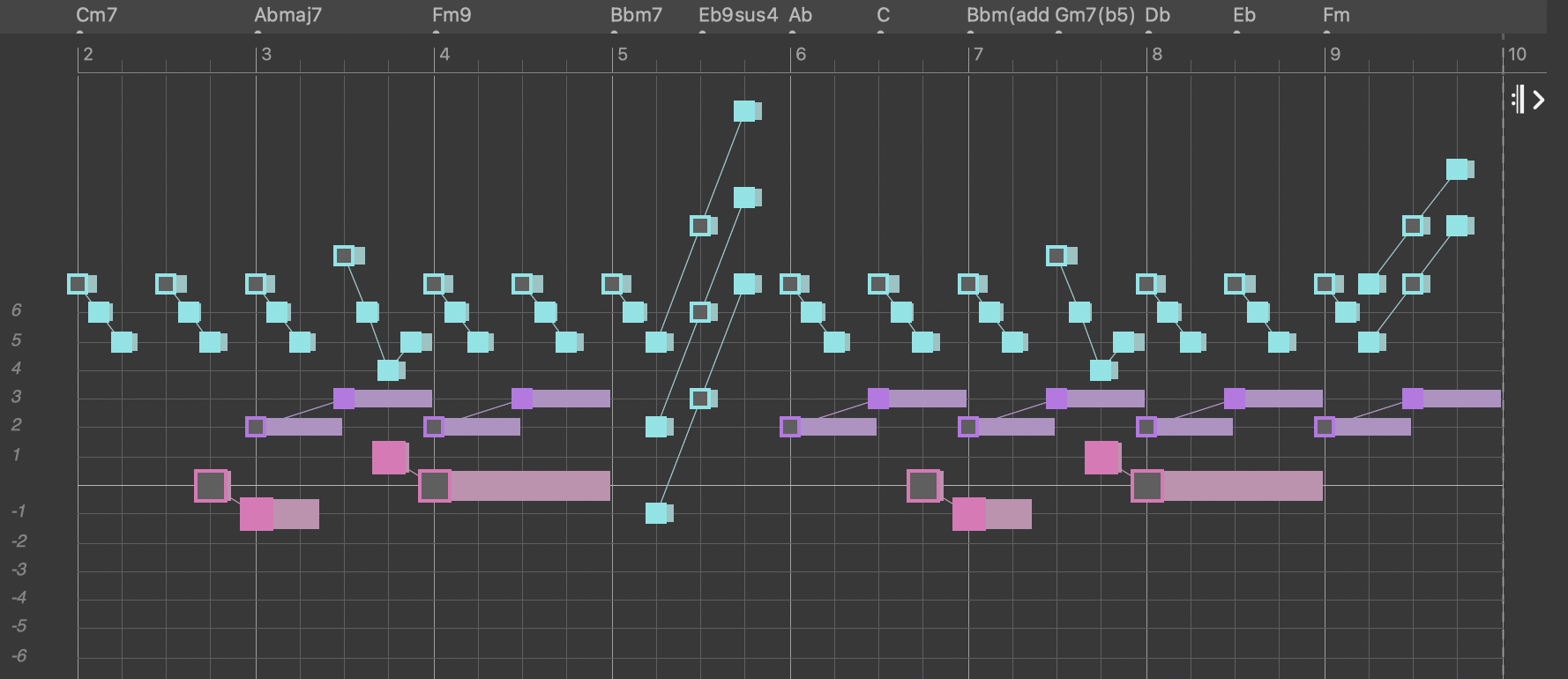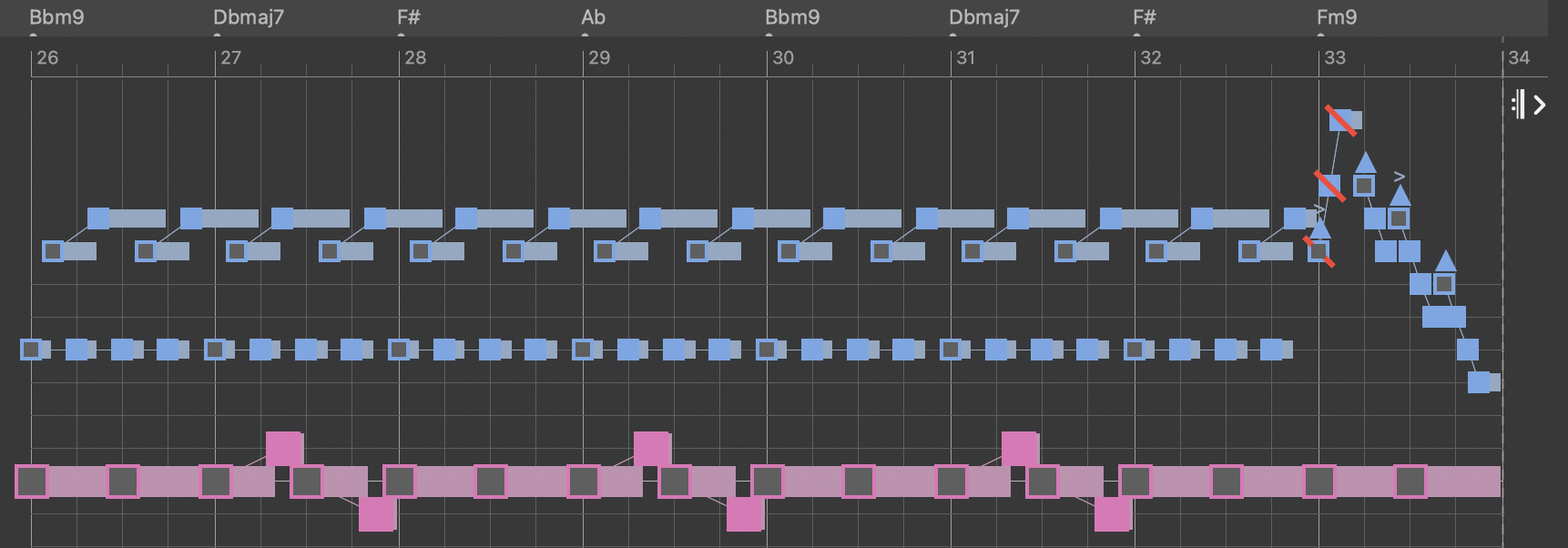
Posted
Here's a new work in progress. I plan on sharing my workflow and the full path how this piece evolved in the coming days. Harmony was initially thought to be modal. At some point it turned functional again. A chord puzzle at the end of part B that I'm still not satisfied with. But more on that later.
Thu, 2024-07-25 - 12:16 Permalink
Harmony
Initially I set out to use C.Spanish-phrygian as a modal scale throughout. I built a palette on that scale and picked all chords off it, so they can all use the same vertical scale (not really, different names but same notes).

This worked fine. At some point I accidentally accepted F.Minor as key. That sounded better to my ears. Probably I am so used to the modes of natural-minor that spanish-phrygian as a permanent scale feels static.

Either way, the difference is very subtle anyway, except for the blue H symbols that are based on F in one version and C in the other.
Important tip: If you change the key, be sure to also transpose your blue H symbols if you want them to result in roughly the same pitch range.
Part B uses the parallel Major key. It adds melodic-major scale to the mix. The puzzle I had to solve was how to get back to part A. The hard cut from Ab to Cm7 sounded very odd, so I had to change its end in order to bridge the gap. This was a lot of trial and error with the palette. I tried secondary dominants but that was even more extreme. If you set the stage smoothly in-key, you can't suddenly jump elsewhere without warning.
Eventually I picked Fm9 as kind of an "open end" that pushes the listener off a cliff (kind of harmonic drop).

As always, it's interesting to see what happens when you throw different harmony at an almost finished piece. It takes you to unexpected places. Sometimes its great and other times it's pointless. I appreciate this as a way to explore what potential there is in the arrangement, maybe for a variation at half speed or something.
modal-piano-5-fluidum.mp3
Thu, 2024-07-25 - 12:56 Permalink
Phrases
I built almost all phrases by hand, drawing, duplicating and moving Figure segments. For the human feel I applied the Velocity of other phrases. Used the shape tool and Dynamics parameter here and there.
The piano phrase in A (1st) is the same as in A (2nd), only at half speed. If you are into sparse atmospheric music, I strongly recommend you try phrases at half speed (or even slower). That thins out everything and leaves plenty room for background and effects to shine through. Since harmony remains at original speed, things fall nicely into line.

Part B (1st) uses this one.

Part B (2nd) this one.

The trumpets with horns in the background.

Other lines are nothing special, just sketched them and nudged symbols up/down with the arrow keys.
Optimizing Phrases For Harmony
When you switch to the Output parameter (or the Overview page), the colors indicate how many bass, chord and scale tones are used. I transposed slow melodic lines a bit to avoid too many of them playing the bass, for example. I also tweaked Interpretation settings to make sure there are more scale tones in the output.
As I am at it, I think it would be great feature to add even more colors, e.g. for the intervals of a chord, such you can see at a glance how much of your chord is actually played.
Thu, 2024-07-25 - 13:28 Permalink
The Challenge
Now comes the most difficult part. This may be a personal thing, but I still don't like the piece. It has beautiful elements, but is altogether too rectangular, well-behaved and evenly paced.
I have a terrible habit of wrapping everything up in a steady rhythm. This takes away a lot of potential from the piece. Together with the functional harmony, it makes it cheesy and, yes, predictable and boring. Pop music, actually.
What I have in mind is an open rhythm with more triplets, melodic lines, counterpoint and contrasts. The trumpets can stay that way, but the background should be less metrical and static.
That's easy with Synfire. I just need to get over myself and break out of this long-standing habit!
I'll post the results here.
If you want to play around with it yourself, I've attached the file.
Sun, 2024-07-28 - 21:58 Permalink
Here's a new version with refined rhythm, melodies and harmony. I like it much better, but as always, the first take still has something that doesn't go out of my head.
Harmony
I replaced the final chord in part B with F(add9) which is out of key but works as a climax with a lot of tension. In the final part - a variation of part A - I added chromatic planing. That is, I simply transposed part of the progression by one semitone up and altered a single chord to serve as a bridge back down (at the end).
Phrases
Phrases are not much different. I edited the piano to use triplets instead of 1/8 right from the start. Added some atmospheric "pings". Added a string section. Copied the french horns also to part A. Oh, and a timpany for drama.

